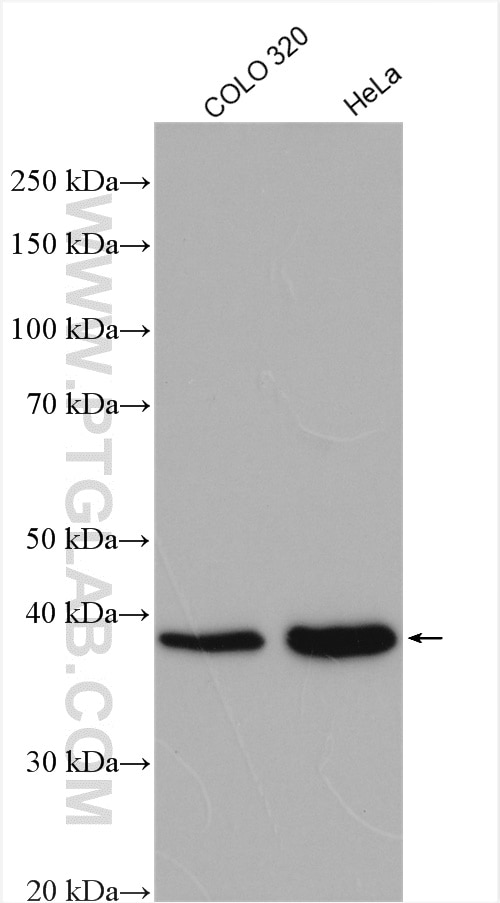Validation Data Gallery
Tested Applications
| Positive WB detected in | COLO 320 cells, HeLa cells |
Recommended dilution
| Application | Dilution |
|---|---|
| Western Blot (WB) | WB : 1:1000-1:8000 |
| It is recommended that this reagent should be titrated in each testing system to obtain optimal results. | |
| Sample-dependent, Check data in validation data gallery. | |
Published Applications
| WB | See 4 publications below |
Product Information
11888-1-AP targets XLF in WB, ELISA applications and shows reactivity with human samples.
| Tested Reactivity | human |
| Cited Reactivity | human |
| Host / Isotype | Rabbit / IgG |
| Class | Polyclonal |
| Type | Antibody |
| Immunogen |
CatNo: Ag2496 Product name: Recombinant human NHEJ1 protein Source: e coli.-derived, PGEX-4T Tag: GST Domain: 1-299 aa of BC030986 Sequence: MEELEQGLLMQPWAWLQLAENSLLAKVFITKQGYALLVSDLQQVWHEQVDTSVVSQRAKELNKRLTAPPAAFLCHLDNLLRPLLKDAAHPSEATFSCDCVADALILRVRSELSGLPFYWNFHCMLASPSLVSQHLIRPLMGMSLALQCQVRELATLLHMKDLEIQDYQESGATLIRDRLKTEPFEENSFLEQFMIEKLPEACSIGDGKPFVMNLQDLYMAVTTQEVQVGQKHQGAGDPHTSNSASLQGIDSQCVNQPEQLVSSAPTLSAPEKESTGTSGPLQRPQLSKVKRKKPRGLFS 相同性解析による交差性が予測される生物種 |
| Full Name | nonhomologous end-joining factor 1 |
| Calculated molecular weight | 35 kDa |
| Observed molecular weight | 33-38 kDa |
| GenBank accession number | BC030986 |
| Gene Symbol | XLF |
| Gene ID (NCBI) | 79840 |
| RRID | AB_2282851 |
| Conjugate | Unconjugated |
| Form | |
| Form | Liquid |
| Purification Method | Antigen affinity purification |
| UNIPROT ID | Q9H9Q4 |
| Storage Buffer | PBS with 0.02% sodium azide and 50% glycerol{{ptg:BufferTemp}}7.3 |
| Storage Conditions | Store at -20°C. Stable for one year after shipment. Aliquoting is unnecessary for -20oC storage. |
Background Information
XRCC4-like factor (XLF), also known as Cernunnos and NHEJ1, is a protein encoded by the human NHEJ1 gene and an important repair factor for DNA double-strand breaks. NHEJ is a well-known mechanism for the repair of double-strand breaks (DSBs), a lethal type of DNA damage in mammalian cells. It basically utilizes a group of enzymes to take hold of the ends of a broken DNA molecule, create a bridge between them, and subsequently re-ligate the broken DNA molecule.
Protocols
| Product Specific Protocols | |
|---|---|
| WB protocol for XLF antibody 11888-1-AP | Download protocol |
| Standard Protocols | |
|---|---|
| Click here to view our Standard Protocols |
Publications
| Species | Application | Title |
|---|---|---|
J Med Genet Haploinsufficiency in non-homologous end joining factor 1 induces ovarian dysfunction in humans and mice. | ||
PLoS One 5-Azacytidine Enhances the Radiosensitivity of CNE2 and SUNE1 Cells In Vitro and In Vivo Possibly by Altering DNA Methylation. | ||
Int J Biochem Cell Biol Targeting Ku86 enhances X-ray-induced radiotherapy sensitivity in serous ovarian cancer cells. | ||
FEBS Lett RNase L facilitates the repair of DNA double-strand breaks through the nonhomologous end-joining pathway. |

